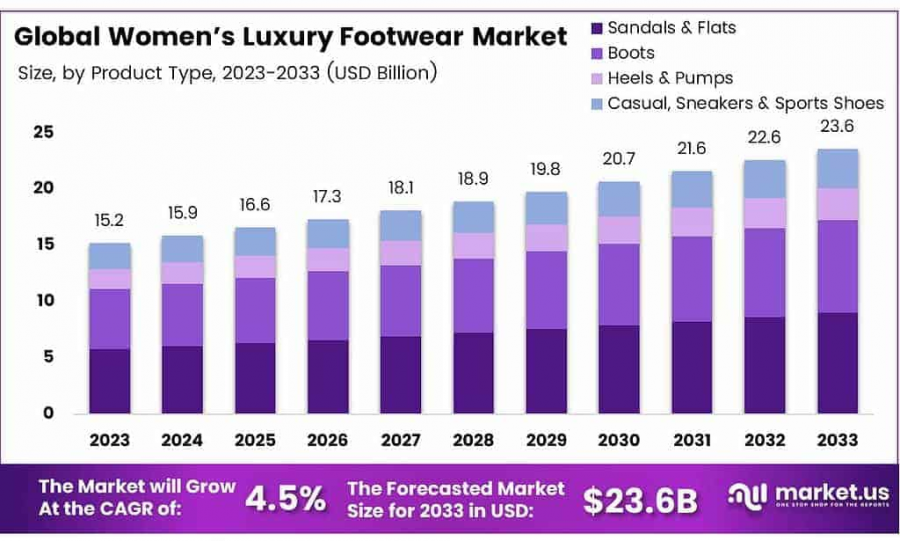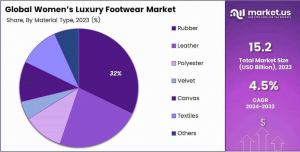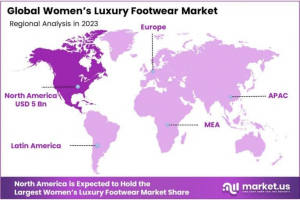
Global Women’s Luxury Footwear Market to Hit USD 23.6 Bn by 2033, Growing at 4.5% CAGR
Women’s Luxury Footwear Market size is expected to be worth around USD 23.6 Bn by 2033, from USD 15.2 Bn in 2023, growing at a CAGR of 4.5%.
NEW YORK, NY, UNITED STATES, January 27, 2025 /EINPresswire.com/ -- Market Overview
The Global Women’s Luxury Footwear Market size is expected to be worth around USD 23.6 Bn by 2033, from USD 15.2 Bn in 2023, growing at a CAGR of 4.5% during the forecast period from 2024 to 2033.
The Women’s Luxury Footwear Market refers to the segment within the broader footwear industry that deals with high-end, premium-priced footwear designed primarily for women. These products are crafted with superior materials, featuring sophisticated designs, and are often associated with prestigious brands. Luxury footwear, characterized by exclusivity, craftsmanship, and high-quality materials, typically targets affluent consumers seeking status, comfort, and style.
The Women's Luxury Footwear Market has seen consistent demand growth over the past several years, driven by evolving consumer preferences for fashion-forward and high-quality products. Increasing disposable incomes, particularly in emerging markets, have contributed to a rise in luxury consumption. As fashion becomes more globalized, women worldwide are now able to access luxury footwear brands, further expanding the market's reach.
There is also a growing demand for personalized and bespoke footwear options, as consumers increasingly seek unique, one-of-a-kind designs that reflect their individual style and personality. Technological advancements in manufacturing processes, coupled with the influence of online platforms and social media, have made luxury footwear more accessible and visible than ever before.
The growth of the Women's Luxury Footwear Market is largely attributed to the expanding middle and upper-middle-class segments in developing economies, where consumer awareness and demand for luxury items are on the rise. In regions like Asia Pacific, governments have played a significant role in stimulating economic growth, which in turn has bolstered the luxury goods sector. Additionally, investment in infrastructure and e-commerce platforms has increased accessibility for consumers globally, propelling growth.
Government regulations surrounding import duties, consumer protection, and intellectual property rights also influence market dynamics. As luxury footwear is a high-value product, ensuring the authenticity of goods and controlling counterfeiting has become a key priority. Compliance with international trade regulations and maintaining transparency in product sourcing will continue to be vital for both established and emerging players in the market.
For both new and existing players, the Women's Luxury Footwear Market presents abundant opportunities for growth. New entrants can leverage e-commerce platforms to reach global audiences, while established brands can focus on expanding their product lines to include eco-friendly and sustainable footwear options, which are increasingly in demand. Additionally, creating exclusive collaborations with fashion designers or influencers can help brands enhance their visibility and appeal to a wider audience. By tapping into emerging markets and staying ahead of consumer trends, businesses can successfully capitalize on the evolving demands of the luxury footwear sector.
Curious About Market Trends? Request Your Complimentary Sample Report Today: https://market.us/report/women-luxury-footwear-market/free-sample/
Key Takeaway
-- The global Women’s Luxury Footwear Market is projected to grow from USD 15.2 billion in 2023 to USD 23.6 billion by 2033, at a CAGR of 4.5%.
-- Sandals & Flats lead the market by product type with a 38.1% share in 2023, favored for their comfort and versatility in both casual and formal settings.
-- Rubber is the predominant material in luxury footwear in 2023, holding a 32.2% market share due to its durability and flexibility, while leather remains a premium choice.
-- Online sales channels dominate the market, reflecting a shift in consumer shopping preferences towards convenience and the use of advanced technologies for a better customer experience.
-- North America holds a significant market share of 33%, valued at USD 5 billion, driven by high disposable income and a strong presence of luxury brands and e-commerce.
Use Cases
1. Fashion Industry Events: Women's luxury footwear is a staple in high-fashion events such as fashion weeks and red carpet events. Designers use these occasions to showcase new collections and styles, influencing trends and preferences in the broader fashion industry. These shoes are not just functional but are seen as a statement of style and status.
2. Professional and Business Settings: In professional and business environments, women's luxury footwear is often chosen for its design and comfort, making it suitable for long working hours while maintaining a high standard of personal appearance. Luxury brands are particularly favored for executive meetings and client interactions where making a good impression is crucial.
3. Retail and Boutique Stores: Luxury footwear finds a significant place in high-end retail and boutique stores. These establishments provide exclusive shopping experiences for customers, offering personalized services such as fittings and styling advice. The presence of luxury footwear enhances the brand value of these stores, attracting a clientele interested in premium quality and exclusivity.
4. Online Luxury Platforms: The rise of e-commerce has expanded the reach of women's luxury footwear. Online luxury platforms offer a wide range of products from various high-end brands, making it easier for customers to purchase luxury footwear from the comfort of their homes. These platforms often provide detailed product descriptions, high-quality images, and customer reviews to help buyers make informed decisions.
5. Special Occasions and Gifting: Women's luxury footwear is popular as gifts for special occasions such as anniversaries, birthdays, and weddings. These shoes are often perceived as a luxury treat or a significant investment in one's wardrobe. They hold sentimental value and are cherished as much for their aesthetic appeal as for their craftsmanship and durability.
Driving Factors
Increasing Disposable Income: As disposable incomes rise, particularly in emerging economies, more women are able to invest in luxury products, including high-end footwear. The growing middle and upper classes in countries like China, India, and Brazil are increasingly driving the demand for luxury footwear.
Celebrity Endorsements and Influencer Marketing: Luxury footwear brands often collaborate with celebrities and influencers to boost brand awareness and desirability. These partnerships create a strong appeal for high-end products, influencing consumer behavior and fueling the demand for luxury shoes.
Rise in Fashion Consciousness: Consumers, especially younger women, are becoming more fashion-conscious and seeking high-quality footwear that aligns with their style and social status. Luxury footwear brands cater to this demand by offering unique designs, premium materials, and exclusivity, thus expanding their customer base.
E-commerce and Online Shopping: The rise of online shopping platforms and e-commerce has made luxury footwear more accessible to global consumers. With improved logistics and personalized online shopping experiences, more women can explore and purchase luxury footwear from the comfort of their homes, boosting market growth.
Brand Loyalty and Heritage: Many women are drawn to well-established luxury footwear brands with a long history and reputation for craftsmanship. The appeal of heritage, craftsmanship, and brand loyalty is a powerful driving force in the market. Consumers tend to prioritize brands that stand for quality, status, and tradition, further fueling demand for luxury footwear.
Report Segmentation
In 2023, Sandals & Flats were the leading products in the "By Product Type Analysis" of the Women’s Luxury Footwear Market, securing a 38.1% share. Their popularity stems from a growing consumer desire for shoes that are both comfortable and stylish, particularly suited for warmer weather and summer months. The ability of sandals and flats to fit seamlessly into both casual and formal occasions has significantly boosted their demand.
In the same year, Rubber was the top material in the "By Material Type Analysis" of the Women’s Luxury Footwear Market, holding a 32% share. Its success is due to rubber's durability and flexibility, which are essential qualities in luxury footwear. Leather also held a strong position in the market, valued for its classic look and high-quality finish, synonymous with luxury. Polyester was another notable material, appreciated for its durability and versatility, making it a good choice for both casual and formal luxury shoes.
By Product Type
~~Boots
~~Heels & Pumps
~~Sandals & Flats
~~Casual, Sneakers & Sports Shoes
By Material Type
~~Rubber
~~Leather
~~Polyester
~~Velvet
~~Canvas
~~Textiles
~~Others
By Sales Channel
~~Offline Sales
~~Department Stores
~~Specialty Stores
~~Monobrand Stores
~~Off-Price Stores
~~Others
~~Online Sales
Ready to Act on Market Opportunities? Buy Your Report Now and Get 30% off: https://market.us/purchase-report/?report_id=131232
Regional Analysis
The Women’s Luxury Footwear Market in North America is robust, holding a significant 33% share with a market value of USD 5 billion. High disposable income and a strong affinity for luxury brands are key drivers of this market. North America benefits from a large number of flagship stores and an extensive online shopping infrastructure, which offers consumers easy access to a wide variety of high-end shoes. Moreover, the market is supported by targeted marketing campaigns and collaborations with celebrities, enhancing its appeal and driving consumer engagement.
Growth Opportunities
Rising Disposable Incomes in Emerging Markets: With increasing disposable incomes in emerging economies like China, India, and Latin America, luxury footwear brands are seeing a rise in demand. Consumers in these regions are becoming more willing to invest in high-end fashion items, including luxury footwear, presenting a lucrative growth opportunity for brands.
Online Shopping and E-commerce Growth: The shift toward online shopping, accelerated by the pandemic, continues to boost the luxury footwear market. E-commerce platforms allow brands to reach global audiences, especially in regions where physical stores are scarce. Investing in online presence and digital marketing strategies will enable luxury footwear brands to tap into this expanding market.
Customization and Personalization: Consumers are increasingly seeking products that reflect their personal style. Luxury footwear brands can capitalize on this trend by offering customization options, such as personalized colors, materials, and designs. This not only enhances the consumer experience but also increases brand loyalty and exclusivity, key drivers in the luxury market.
Sustainability in Fashion: Sustainability is a growing trend across all sectors, and the luxury footwear industry is no exception. Eco-conscious consumers are looking for brands that prioritize sustainable sourcing, ethical manufacturing practices, and the use of recycled or organic materials. Luxury footwear companies that integrate sustainability into their offerings stand to attract a loyal, environmentally aware customer base.
Celebrity and Influencer Endorsements: High-profile endorsements from celebrities and influencers have a significant impact on the luxury fashion market. Collaborations between footwear brands and well-known figures can drive demand and increase brand visibility. Luxury footwear companies can explore strategic partnerships to tap into new consumer bases and enhance their brand’s exclusivity and appeal.
Key Players
Kering
Burberry
Caleres
NIKE, Inc.
Capri Holdings Limited
Jimmy Choo PLC
Christian Dior
Skechers
Under Armour, Inc.
Ariat International, Inc.
Catwalk Worldwide Pvt. Ltd.
Wolverine World Wide, Inc.
JGGR S.R.L
Manolo Blahnik International Limited
Adidas Group
Not Sure? Request a Sample Report and See How Our Insights Can Drive Your Business: https://market.us/report/women-luxury-footwear-market/free-sample/
Trending Factors
Growing Affinity for Sustainable Luxury
Consumers are becoming more conscious of environmental and ethical practices. As a result, luxury footwear brands are increasingly adopting sustainable materials such as vegan leather, recycled fabrics, and eco-friendly dyes. This trend is being driven by younger consumers who prioritize sustainability along with style.
Personalization and Customization Trends
Personalization is becoming a key selling point in the luxury footwear market. Consumers now expect the option to customize their shoes in terms of color, materials, and even monograms. This shift toward individualized products is helping brands foster stronger connections with their customers.
E-commerce and Direct-to-Consumer Sales
Online sales for luxury goods, including women’s footwear, are growing rapidly. Luxury brands are investing heavily in e-commerce platforms to provide a more seamless shopping experience. Direct-to-consumer models are also gaining popularity, allowing brands to connect directly with customers, bypassing traditional retail channels.
Celebrity and Influencer Endorsements
Celebrity culture and social media influencers continue to have a significant impact on the luxury fashion market. Women's luxury footwear brands are leveraging partnerships with high-profile individuals to enhance their brand image and boost sales. Social media campaigns showcasing footwear worn by celebrities have a powerful influence on consumer behavior.
Expansion of Athleisure and Comfort-Luxury Shoes
The rise of athleisure has led to a demand for stylish yet comfortable footwear in the luxury segment. Brands are now designing high-end sneakers and hybrid shoes that combine comfort with luxury aesthetics. This trend is appealing to consumers who desire both practicality and elegance, especially in casual wear.
Restraining Factors
Economic Downturns Affecting Consumer Spending: The women's luxury footwear market is highly sensitive to changes in economic conditions. During times of economic uncertainty or recession, consumers often prioritize essential purchases over luxury items. As a result, demand for high-end footwear may decline, limiting sales and growth potential. This is particularly true in regions where discretionary income is affected by financial instability or inflation.
Intense Competition from Fast Fashion: Fast fashion brands have created significant competition for the luxury footwear market. These brands offer trendy, stylish, and affordable alternatives that appeal to a large portion of consumers. While they may not match the premium quality or exclusivity of luxury brands, their lower price points make them a more attractive option for budget-conscious buyers. This creates pressure for luxury footwear brands to innovate continuously and offer unique designs to maintain their customer base.
Conclusion
In conclusion, the Global Women's Luxury Footwear Market is poised for steady growth, with projections showing an increase from USD 15.2 billion in 2023 to USD 23.6 billion by 2033. This growth is fueled by increasing disposable incomes, particularly in emerging markets, and a burgeoning interest in fashion-forward, high-quality products. The market benefits from the rising trend of personalization and customization, allowing consumers to express individuality through unique, bespoke designs. Additionally, the shift towards online sales channels continues to play a pivotal role, making luxury footwear more accessible globally. However, challenges such as economic downturns and competition from fast fashion brands remain significant hurdles. Despite these challenges, the luxury footwear market has substantial opportunities for growth, especially if brands can successfully integrate sustainability and innovation into their offerings, tapping into the growing demand for eco-friendly products and enhancing their appeal to a broader, more discerning consumer base.
Related Reports
Vegan Womens Fashion Market: https://market.us/report/vegan-womens-fashion-market/
Winter Wear Market: https://market.us/report/winter-wear-market/
Custom Made Clothes Market: https://market.us/report/custom-made-clothes-market/
Body Shapewear Market: https://market.us/report/body-shapewear-market/
Smart Clothing Market: https://market.us/report/smart-clothing-market/
Lawrence John
Prudour
+91 91308 55334
Lawrence@prudour.com
Visit us on social media:
Facebook
LinkedIn
Distribution channels: Consumer Goods
Legal Disclaimer:
EIN Presswire provides this news content "as is" without warranty of any kind. We do not accept any responsibility or liability for the accuracy, content, images, videos, licenses, completeness, legality, or reliability of the information contained in this article. If you have any complaints or copyright issues related to this article, kindly contact the author above.
Submit your press release


